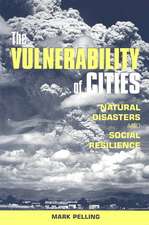Walking in the European City: Quotidian Mobility and Urban Ethnography
Autor Timothy Shortell, Evrick Brownen Limba Engleză Paperback – 26 oct 2016
| Toate formatele și edițiile | Preț | Express |
|---|---|---|
| Paperback (1) | 489.26 lei 6-8 săpt. | |
| Taylor & Francis – 26 oct 2016 | 489.26 lei 6-8 săpt. | |
| Hardback (1) | 1060.74 lei 6-8 săpt. | |
| Taylor & Francis – 28 apr 2014 | 1060.74 lei 6-8 săpt. |
Preț: 489.26 lei
Nou
Puncte Express: 734
Preț estimativ în valută:
93.63€ • 97.39$ • 77.30£
93.63€ • 97.39$ • 77.30£
Carte tipărită la comandă
Livrare economică 14-28 aprilie
Preluare comenzi: 021 569.72.76
Specificații
ISBN-13: 9781138272781
ISBN-10: 1138272787
Pagini: 320
Dimensiuni: 156 x 234 x 23 mm
Greutate: 0.45 kg
Ediția:1
Editura: Taylor & Francis
Colecția Routledge
Locul publicării:Oxford, United Kingdom
ISBN-10: 1138272787
Pagini: 320
Dimensiuni: 156 x 234 x 23 mm
Greutate: 0.45 kg
Ediția:1
Editura: Taylor & Francis
Colecția Routledge
Locul publicării:Oxford, United Kingdom
Notă biografică
Timothy Shortell is Associate Professor of Sociology at Brooklyn College, City University of New York, USA and co-editor of The World in Brooklyn. Evrick Brown is an Adjunct Assistant Professor in the Behavioral Sciences and Human Services Department at Kingsborough Community College of the City University of New York, USA.
Recenzii
’While illuminating walking as both a social activity and method for studying urban locales, Shortell and Brown contribute a unique perspective to urban theory and research with this groundbreaking book. The collection of chapters reveals innovative approaches to analyzing cities in Europe. It is a must-read for urban scholars, students, and anyone who loves cities.’ Judith N. DeSena, St. John's University, New York City, USA ’Walking is a fundamental way of interacting with and making sense of the urban environment for everyday urbanites and students of urban life alike. Shortell and Brown have put together a wonderful collection of studies that show how the tactile act of walking connects the body - as an instrument of knowledge and power - and the city it travels through.’ Michael Ian Borer, University of Nevada, Las Vegas, USA 'The present volume has a refreshingly wide scope, with 14 chapters by different authors, offering insights on urban walking in the UK, France, Italy, Greece, Norway, Sweden, Denmark, Switzerland, Czech Republic, Turkey and Bosnia. ... Overall, the book presents concepts and methods that appeal to sociologists, anthropologists and geographers. It also gives useful ideas on how to use walking as an educational experience. ... the book provides interesting insights on urban mobility and on the connections between the role of walking in society and in social science.' Urban Geography Research Group
Cuprins
1: Introduction: Walking in the European City; I: Theoretical Elaborations; 2: The Flâneur: A Way of Walking, Exploring and Interpreting the City; 3: The Act of Walking: Exemplifying Danish Pedestrian Culture; 4: Moving Through the City with Strangers? Public Transport as a Significant Type of Urban Public Space; 5: Walking Between Planes: Why Hypermobile People Take to Walking in the City; 6: Mobility in Thessaloniki: The Greek Economic Crisis and the Transformation of Mobility; II: Visual Methods; 7: Drifting in Chinatowns: Toward a Situationist Analysis of Polyglot Urban Spaces in New York, Paris, and London; 8: Walking Through Instead of Flying Over: A Way to See the Flux of Urbanization in Istanbul and Other Places?; 9: Walking in Search of Migrants in European Cities; 10: Walking the Stream: Prague Cityscape and the Research Guided by the Water; III: Ethnographic Approaches; 11: Gdje si? Walking as a Reflexive Practice; 12: Challenging the Hegemonic Gaze on Foot: Walk-Alongs as a Useful Method in Gentrification Research; 13: A Walk Around the Block: Creating Spaces for Everyday Encounters; 14: Walking Through Urban Transformation: Fieldwork in the Northeast of Paris
Descriere
Sociologists have long noted that dynamism is an essential part of the urban way of life. However, walking as a significant social activity and crucial research method (in spite of its ubiquity as part of urban life) has often been overlooked. Bringing together new research on sites across Europe, Walking in the European City addresses the nature of everyday mobility in contemporary urban settings, shedding light not only on the ways in which walking relates to other social institutions and practices, but also as a method for studying urban life.












